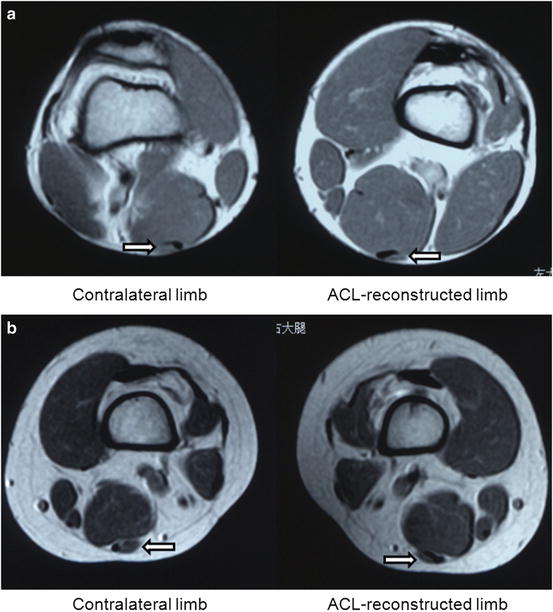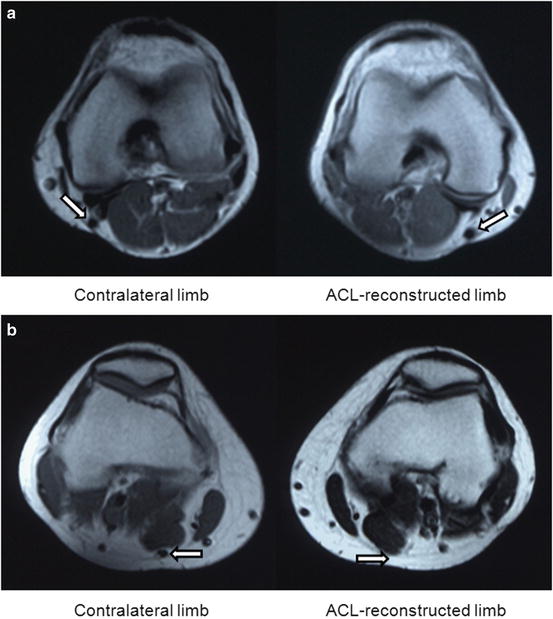Contralateral limb
ACL-reconstructed limb
Muscle volume of the ST (cm3)
152.5 ± 65.5
111.4 ± 55.7a
Muscle length of the ST (cm)
28.1 ± 3.1
24.3 ± 4.3a
The muscle length of the ST in the reconstructed limb (24.3 ± 4.3 cm) was significantly shorter than in the contralateral limb (28.1 ± 3.1 cm; P < 0.0001) (Table 22.1). In 19 of the 23 patients, the shorter muscle length of the ST was attributable to a proximal shift of the distal musculotendinous junction in the ACL-reconstructed limb (Fig. 22.1a). In the remaining four patients, the length of the ST in the reconstructed limb was the same as in the contralateral limb (Fig. 22.1b).


Fig. 22.1
MRI of the distal musculotendinous junction (arrow) (Nishino et al. 2006). (a) The musculotendinous junction of the reconstructed limb shifted proximally compared with that of the contralateral limb. (b) The musculotendinous junction of the reconstructed limb was at the same level as that of the contralateral limb
In 21 of the 23 patients, regeneration of an ST tendon-like structure was confirmed (Fig. 22.2a). In these patients, the entire regenerated tendon-like structure passed the knee joint and inserted into the distal structures. In the remaining two patients, a tendon-like structure was not identified (Fig. 22.2b).


Fig. 22.2
MRI of the ST tendon (arrow) (Nishino et al. 2006). (a) Tendon-like structure of the ST was confirmed at the ST tendon harvest site. (b) Tendon-like structure of the ST could not be identified at the ST tendon harvest site
22.3 Relationship Between Knee Flexion Strength and Morphology of the Semitendinosus Muscle-Tendon Complex After Harvesting Its Tendon
Based on the morphological changes in the ST muscle-tendon complex after harvesting its tendon, patients were divided into three groups. In four patients, regeneration of an ST tendon-like structure was confirmed, and the ST muscle length of the ACL-reconstructed limb was the same as that of the contralateral limb (group I). In 17 patients, regeneration of an ST tendon-like structure was also confirmed; however, the ST muscle of the ACL-reconstructed limb was shorter than that of the contralateral limb (group II). In the remaining two patients, an ST tendon-like structure could not be identified, and the length of the ST muscle of the ACL-reconstructed limb was shorter than that of the contralateral limb (group III).
To evaluate the relationship between knee flexion strength and morphological changes in the ST muscle-tendon complex after harvesting the ST tendon for ACL reconstruction, the percentage of muscle volume and length of the ST and knee flexion torque in the ACL-reconstructed limb relative to those in the contralateral limb (% contralateral) were summarized in Table 22.2 for each of the three groups mentioned above. In the patients in group I, the isometric knee flexion torque of the reconstructed limb was similar to that of the contralateral limb at both 45° and 90° of knee flexion. In group II, knee flexion torque of the reconstructed limbs was similar to the contralateral limb at 45°; however, the torque value at 90° tended to be lower than that of the contralateral limb. In group III, knee flexion torque of the reconstructed limbs tended to be considerably lower than that of the contralateral limbs at both 45° and 90°.
Table 22.2
Summarization of the percentages of the measured variables in the ACL reconstructed limb to those in the contralateral limb for the three patient’s groups (% contralateral) (Nishino et al. 2006)
Group I (n = 4) | Group II (n = 17) | Group III (n = 2) | |
|---|---|---|---|
Tendon-like structure of the ST | Regenerated | Regenerated | Unidentified |
Muscle length of the ST (%) | 100 | 86.5 ± 6.0 | 58.2 ± 8.2 |
Muscle volume of the ST (%) | 85.6 ± 18.0 | 74.8 ± 13.9 | 37.4 ± 10.8 |
Knee flexion torque at 45° (%) | 101.3 ± 7.7 | 96.7 ± 13.6 | 57.4 ± 0.4 |
Knee flexion torque at 90° (%) | 98.0 ± 37.3 | 71.9 ± 21.6 | 44.4 ± 8.5 |
22.4 Function of the Semitendinosus Muscle-Tendon Complex After Harvesting Its Tendon
The findings described in the previous subsection indicate that changes in knee flexion strength are associated with the degree of morphological change in the ST as a muscle-tendon complex after harvesting its tendon for ACL reconstruction. The deficits in knee flexion strength of the ST tendon-harvested limb are partly explained by the morphological changes in the ST muscle-tendon complex.
For the patients with regeneration of the ST tendon-like structure at the ST tendon-harvested site (groups I and II), knee flexion torque of the ST tendon-harvested limb was recovered at shallow knee flexion angles. In all cases with regeneration, the regenerated tendon-like structure passed the knee joint and inserted into the structures distal to the knee joint. On the other hand, patients without regeneration of the tendon-like structure (group III) demonstrated deficits of knee flexion torque at both shallow and deep knee flexion, most likely because of the lack of a functional tendon to transmit forces from the ST to the tibia. Taken together, our results indicate that the regenerated tendon-like structure has a function similar to that of the native ST tendon when contributing to knee flexion. The functionality of the regenerated tendon-like structure is supported by several studies (Eriksson et al. 2001b; Ferretti et al. 2002; Hioki et al. 2003). The histological study of Ferretti et al. (2002) indicated that the regenerated ST tendon seemed to be very similar to a normal tendon. Eriksson et al. (2001b) reported that adequate tension in the regenerated ST tendon was created by voluntary muscle contraction. Hioki et al. (2003) used a novel MRI technique called the tagging snapshot technique and claimed that the ST with a regenerated tendon-like structure moved proximally during active knee flexion.
Stay updated, free articles. Join our Telegram channel

Full access? Get Clinical Tree








